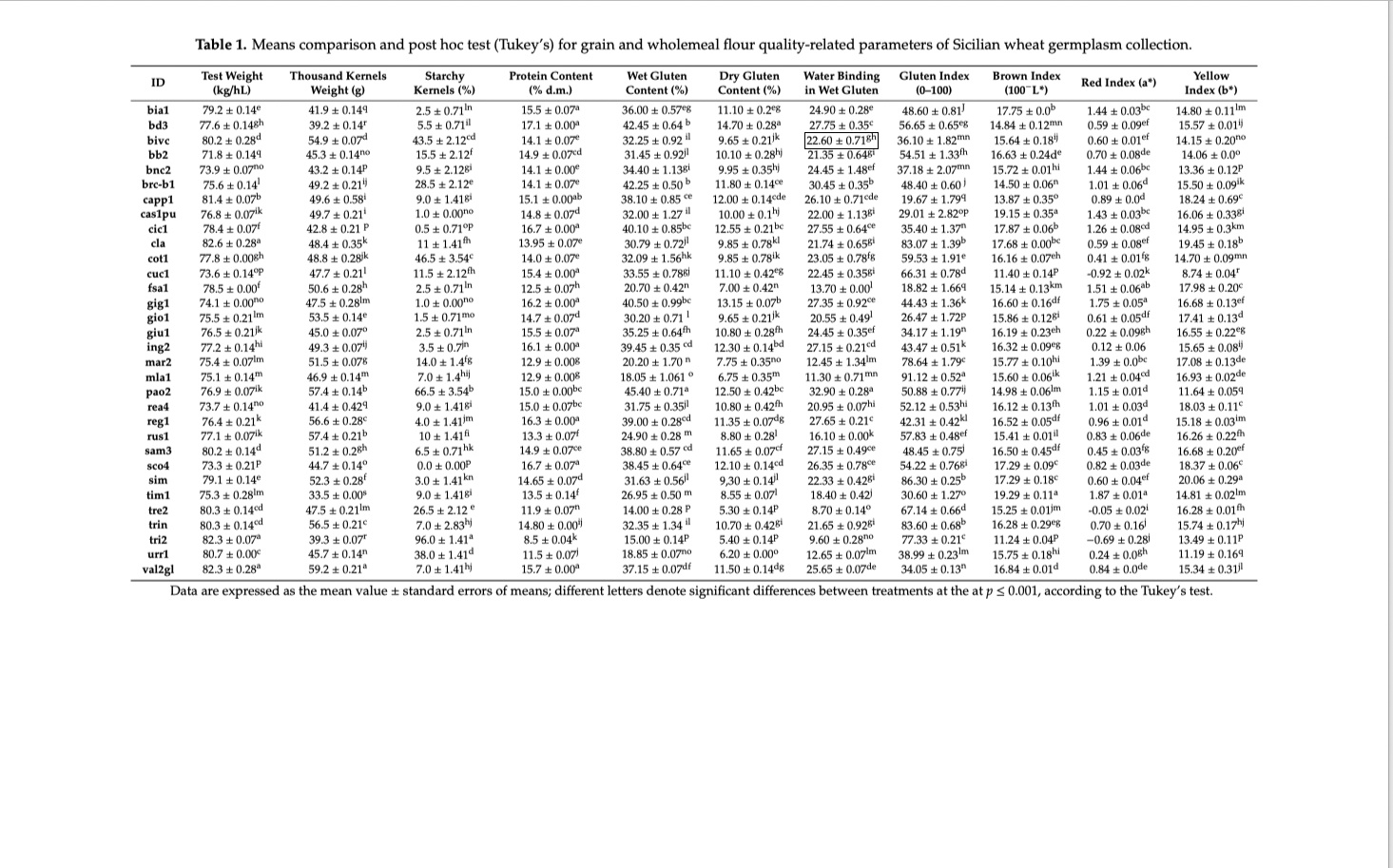Characterization of a collection of durum wheat landraces from Sicily, using single nucleotide polymorphisms (SNP) markers (provide a genetic fringeprint very usefull for avoiding commercial frauds).
Abstract: During the XX Century, the widespread use of modern wheat cultivars drastically reduced the cultivation of ancient landraces, which nowadays are confined to niche cultivation areas. Several durum wheat landraces adapted to the extreme environments of the Mediterranean region, are still being cultivated in Sicily, Italy. Detailed knowledge of the genetic diversity of this germplasm could lay the basis for their efficient management in breeding programs, for a wide-range range of traits. The aim of the present study was to characterize a collection of durum wheat landraces from Sicily, using single nucleotide polymorphisms (SNP) markers, together with agro-morphological, phenological and quality-related traits. Two modern cv. Simeto, Claudio, and the hexaploid landrace, Cuccitta, were used as outgroups. Cluster analysis and Principal Coordinates Analysis (PCoA) allowed us to identify four main clusters across the analyzed germplasm, among which a cluster included only historical and modern varieties. Likewise, structure analysis was able to distinguish the ancient varieties from the others, grouping the entries in seven cryptic genetic clusters. Furthermore, a Principal Component Analysis (PCA) was able to separate the modern testers from the ancient germplasm. This approach was useful to classify and evaluate Sicilian ancient wheat germplasm, supporting their safeguard and providing a genetic fingerprint that is necessary for avoiding commercial frauds to sustaining the economic profits of farmers resorting to landraces cultivation. (High-Throughput Genotype, Morphology, and Quality Traits Evaluation for the Assessment of Genetic Diversity of Wheat Landraces from Sicily. Maria Carola Fiore , Francesco Mercati, Alfio Spina, Sebastiano Blangiforti, Gianfranco Venora, Matteo Dell’Acqua, Antonio Lupini, Giovanni Preiti , Michele Monti, Mario Enrico Pè and Francesco Sunseri. 30 aprile 2019.)
Table 1
List of grains examined

Table 2
Characteristics of the grains examined

Gluten: amino acids, digestion, toxic peptides
Gliadin and Glutenin
They are the wheat proteins (gliadin, soluble in alcohol and glutenin, insoluble in alcohol) and are composed of amino acid chains (1). Gliadin is made up of the union of about 100-200 amino acids (the main cause of celiac disease), and glutenin, consisting of a combination of about 2,000-20,000 amino acids. The covalent bond that unites two amino acids also takes the name in biochemistry of “peptide bond”. A chain of multiple amino acids linked through peptide bonds takes the generic name of peptide or polypeptide or oligopeptide if the number of amino acids involved is limited; one or more polypeptides, sometimes accompanied by other auxiliary structures or ions called cofactors or prosthetic groups, constitute a protein. amino-acids (or amminoacids) are the primary structural unit of proteins. We can therefore imagine the amino acids as bricks that, united by a glue called peptide bond, form a long sequence that gives rise to a protein. Alcohol soluble cereal proteins are called: prolamines.
The wheat prolamine is gliadin, that of barley is hordein; that of rye is secaline, that of avena is avenin. The different types of prolamins contain different amino-acids and the higher the content of proline and glutamine (which are some of the amino-acids that compose it) the more the prolamine, and therefore the peptides of that cereal will be toxic (2) for the affected patient from celiac disease. The highest levels of proline and glutamine are in wheat, barley and rye. Also glutenins have some toxic sequences for celiacs but they appear to be much less active in soliciting the adverse response of the humanitarian system of man.

Scouting for Naturally Low-Toxicity Wheat Genotypes by a Multidisciplinary Approach
Scouting for Naturally Low-Toxicity Wheat Genotypes by a Multidisciplinary Approach
It is the first study focused on the search for grains “naturally” with low toxicity to obtain gluten-free products without affecting the rheological properties of wheat. It is emphasized in the study as “In the last decade, the ingestion of wheat has been associated with clinical disorders, such as celiac disease (CD),wheat allergy (WA) and non-celiac gluten sensitivity (NCGS), which are becoming epidemiologically more and more relevant with an estimated global prevalence of about 5%. The trigger factor eliciting CD and WA are largely investigated, while on the contrary the pathophysiology of NCGS is still poorly understood.” The sensitivity to non-celiac gluten, although not completely defined, is however also related to gluten and its toxic fractions (1) (2) (3).
Scientific research has, for some time, emphasized the importance of “decreasing the exposure of gluten to genetically predisposed people” and one way to do this is also to introduce products made with grains with low toxicity into the diet (research concerning ID331 einkorn wheat, considered among the most digestible and the most tolerable, has long underlined this aspect).
Note
(1) – Time for sifting the grain (2015). Luca Elli, Leda Roncoroni, and Maria Teresa Bardella. World J Gastroenterol. 2015 Jul 21; 21(27): 8221–8226. PMCID: PMC4507091 Published online 2015 Jul 21.
(2) – Differentiation between Celiac Disease, Nonceliac Gluten Sensitivity, and their overlapping with Crohn’s disease: A case series. Aristo Vojdani and David Perlmutter. Decemder 2012.
(3) – Gluten Immunogenic Peptides as Standard for the Evaluation of Potential Harmful Prolamin Content in Food and Human Specimen. Ángel Cebolla, María de Lourdes Moreno, Laura Coto, Carolina Sousa. Nutriens 5 December 2018.
